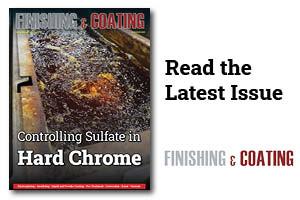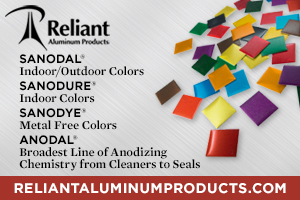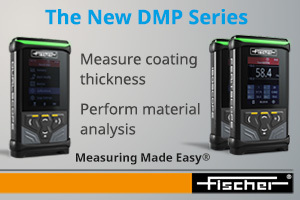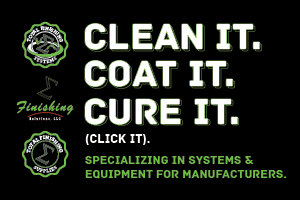In our daily lives, we undoubtedly follow up on various activities and projects, determining if there is an advantage or disadvantage.
 Stephen Rudy, CEFIn many instances, finances in the form of cost versus economy become relevant factors. The driving force is to get the most improved situation at the least expense. This could not be more relevant or appropriate in today’s metal finishing industry. Whether a supplier or end product user, one has to balance operating costs versus price increases and competition to maintain customer relationships. Unfortunately, price increases are not just encountered once or twice a year. It is a consistent challenge encompassing many related costs.
Stephen Rudy, CEFIn many instances, finances in the form of cost versus economy become relevant factors. The driving force is to get the most improved situation at the least expense. This could not be more relevant or appropriate in today’s metal finishing industry. Whether a supplier or end product user, one has to balance operating costs versus price increases and competition to maintain customer relationships. Unfortunately, price increases are not just encountered once or twice a year. It is a consistent challenge encompassing many related costs.
Based on supply and demand, price increases are typically acknowledged. Decreases occur, however, not nearly to the equal of increases. Insurance and health care coverage continually increase. Add to this fuel, which hits us all heavily across every facet of operation. Suppliers consume energy to synthesize, blend, package, and ship products. Finishers require energy sources to maintain bath temperatures, process work, and ship finished parts. We are meeting a zone in which it is at times difficult to pass along price increases.
However, what must be adjusted financially? This critical issue can be addressed by evaluating the bottom line with respect to the operation. It can never be said that there are no ways to reduce operating costs. Looking at the system, improvements can be identified that result in lowering these costs. This certainly helps to offset the price of doing business. In fact, associated savings may keep certain areas economically stable. Let us consider some areas of change that may lower operating costs and perhaps improve the operating system.
Parts
Parts are the lifeblood of our industry. Manufacturers need to advise the finisher of any changes to them. Some concerns are switching to different processing oils, heat treatment, and the grade of base material. Any changes in the routine for these and other steps have raised some major problems in surface preparation. It is therefore important to communicate any such changes or revisions, thereby alerting the finisher to practical modifications necessary in their operating cycle. Fabrication of parts is also very important. It is not unusual to advise or suggest minor alterations that would facilitate the finisher’s job.
Examples are drilled holes to improve drainage, casting or stamping parts in an orientation that minimizes nesting in barrels, and better racking. Larger bulk shipments from the customer of various parts reduce related shipping costs both ways. Small parts for barrel finishing may be handled in a bulk surface preparation, such as ambient temperature mass finishing. This would eliminate a series of surface preparation tanks (hot soak and electrocleaners) and their rinse tanks. It would also save steps, time, and effort.
Product Selections
Suppliers provide a wide range of proprietary systems for just about any type of requirement. By considering surface preparation, soak cleaning can be achieved using emulsification or displacement cleaners. The benefit of displacement cleaning is that oils are continually displaced to be removed manually or mechanically. This process extends the service life of the cleaner. It relates to less downtime, fewer scheduled dumps, reduced consumption of cleaner, and easing the burden in waste treatment. Advances have been made in the use of membrane technology to remove accumulated oils, grease, and shop dirt, transforming the cleaner into a no-dump or much less frequent dump cycle. What to do with significant accumulations of oil? There are used oil facilities that, upon testing samples of the oils, may determine viability to process into recycled products, thereby taking them. Another option is, upon initial compatibility testing, to mix a quantity of the used oil with #2 fuel oil to burn in the plant boilers. These examples are realistic and can be calculated as operating cost savings.
By considering cleaners, let’s take it a step further. The finisher has a choice of powder versus liquid cleaners. We can assume both types of cleaners provide equivalent hard surface cleaning effectiveness. Liquid cleaners, supplied as concentrates, may be slightly more expensive. However, there are operating and safety benefits that can be attributed to the liquid cleaner. Examples include: easier & safer to handle and dispense, uniform product concentrate that does not require premixing, 75-80% less sludging than powders, accurate and simpler process control, F-006 compliance, less inventory, and economical packaging, and larger volumes shipped in returnable totes. Each benefit can be further highlighted.
Empty totes can be exchanged with the supplier for full totes, thereby eliminating disposal issues on both ends. Product totes and drums can be stored in areas further away from a potentially cluttered and tight floor space in a plating or anodizing process line. Cleaner concentrates can be automatically pumped through conveniently installed plumbing directly to the cleaner tank. The setup may include a peristaltic pump that is activated by a conductivity meter wired to a probe, dosing the required liquid cleaner to continually meet the desired operating concentration. This is a very effective means of monitoring concentration as it is related to the solution’s conductivity. With this setup, the operator does not have to manually add cleaner or spend time in related functions.
Monitor Level of Cleaner Concentrate
Less direct handling of these chemicals is a safety benefit, which should be a plus with OSHA and the insurance company. All that is required is to monitor the level of cleaner concentrate in the drum or tote. Plant staff only need to calibrate probes and maintain their cleanliness. The automatic dosing of the cleaner will closely maintain its concentration at the initial makeup. This significantly helps to minimize rejects due to poor cleaning.
In some instances, the cleaner concentrate may be dosed in a specific ratio with liquid 50% caustic soda in the soak tank and a specific ratio in the electrocleaner tank. This allows the finisher to reduce inventory and use the same products in two cleaner tanks. In fact, where applicable, one liquid cleaner concentrate may function as a combination soak and electrocleaner in the same tank or in separate tanks, without a rinse in between.
Because liquid cleaners contain fewer solids, they are less sludgy. This makes tank preparation after dumps easier and quicker. It also speeds up the application of new makeup, reducing overall downtime, so that production can resume. Due to less sludging, the precipitation of heavy metals in waste treatment is easier and more complete. It may also result in less consumption of waste treatment products. Less sludge is also very beneficial to F-006 regulations.
These are some of the practical, cost-effective benefits of considering liquid cleaner concentrates. Savings can really help the bottom line, offsetting expenses that continually roll along.
Stephen F. Rudy, CEF, is president of Chem Analytic and has written extensively about the finishing industry. Visit www.chemanalytic.com or call him at 917-604-5001.



































